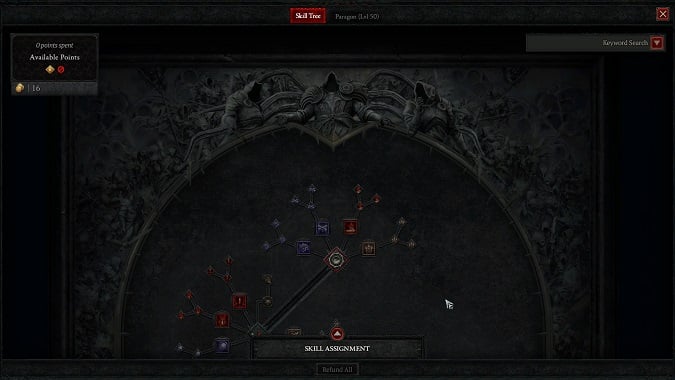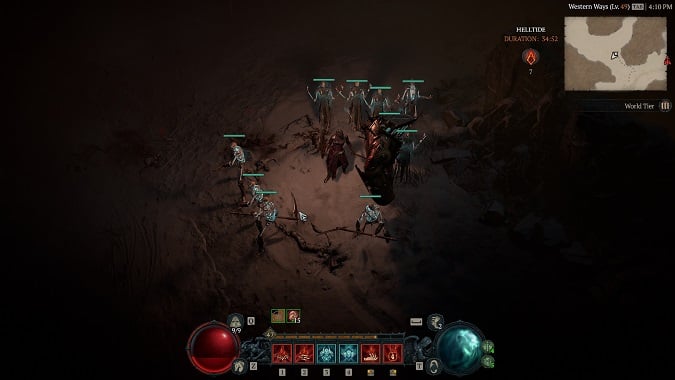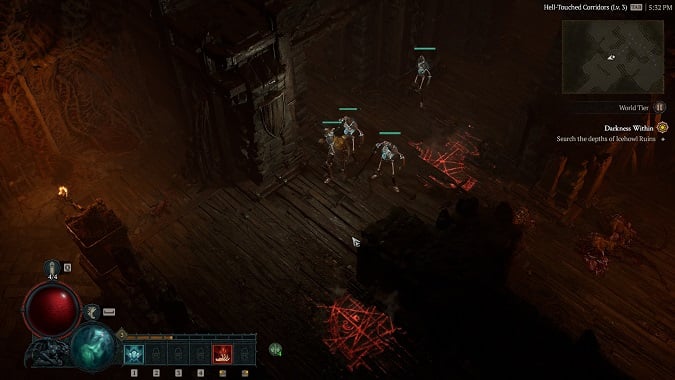How to get started with the Necromancer in Diablo 4

The Necromancer is the master of life and death in the Diablo franchise. In Diablo 4, Necros slam down curses, summon minions, and swing scythes with incredible ease for ultimately fatal results. If that sounds like the playstyle for you, let’s explore the basics of the Necromancer class.
What is a Necromancer in Diablo 4?
Necromancers are a caster class in Diablo 4, focused on weaponizing death to mow their way through the demonic invaders of Sanctuary. Necros summon skeletons and golems to fight on their behalf or wield the powers of Blood, Bone, and Shadow to deal damage. Their caster health pool can lead to quick deaths without defending themselves with blood power, curses, and a protective wall of minions surrounding them. Sadly, they do not (yet) have any mobility skills, such as Blood Rush for the Diablo 3 Necromancer.
Similar to Diablo 2, classes in Diablo 4 make use of all primary stats:
- Strength maps 1-to-1 with your Armor.
- Intelligence adds to Skill Damage and Elemental Resistance.
- Willpower boosts Resource Generation, Healing Received, and Overpower damage.
- Dexterity increases Critical Strike Chance and Dodge Chance.
The Necromancer’s resource, Essence, is regenerated by Basic skills and through specific passive talents and Legendary abilities. Essence is then spent on both Core and Curse skills. But Necromancers use another resource naturally occurring on the battlefield — Corpses. Corpses can be used for damage via Corpse Explosion / Corpse Tendrils and to power your skeletal army.

Necromantic Specialty: Book of the Dead
Before diving into the Necromancer’s abilities, let’s touch on the Book of the Dead. Necromancers are unique in that they have access to summoning (the foundation of their class-specific system) from the very beginning. When you start in that freezing cave, you can summon minions from enemy corpses, with a max of four Skeletal Warriors to start. At level 5, you can access your Book of the Dead from your Character panel. Level 15 opens up Skeletal Mages, expanding the forces you can summon to include three mages in your pool of undead defenders. The Golem is unlocked via questline at level 25.
Each minion has three types underneath it, with a choice between two options to buff to the pet or one buff for yourself… if you sacrifice the ability to summon that minion. But you can only pick one option of the nine total for that minion. Early on, you can gain more from maintaining your forces for leveling and survival than you do from individual sacrifices. After all, you shouldn’t get hit if they take the hits for you!
You have a max of 8 pets at your disposal by level 25. However, you can grow your Necromancer’s pet army through the Occult Dominion aspect, which increases your number of Skeletal Mages and Skeletal Warriors. Additionally, a variety of Legendary Aspects and skill tree Passives are available for the Necromancer to increase the damage and survivability of your minions.
But before you get there, you’ll have to understand the basics of your skill tree to level up and collect all of the options in your Book of the Dead.

Necromancer skill tree basics
Each class in Diablo 4 has seven sections to their class tree — four universal sections (Basic, Core, Ultimate, and Key Passives) and three class-specific sections. The Necromancer’s middle skill groupings in the tree contain Corpse, Macabre, and Curse abilities. Passive skills that boost your other abilities are available in every group in the tree except Basic. Keep these sectional titles in mind; they help power the keyword search in the Skills Tree.
Necromancer skills are broken into three major types — Blood and Bone deliver Physical damage, and Darkness hits with Shadow. While not critical to early gameplay, you want to keep these in mind as you develop your build. Maintaining a damage type across your skills is excellent for leveraging boosts from passives or Legendaries. That said, when you unlock higher difficulty tiers, some enemies will have damage resistance that can thwart you (similar to D2). Therefore, consider keeping some extracted Legendary aspects or extra gear handy in your Stash to leverage for alternate builds if you find yourself struggling.
Like Diablo 2, you earn skill points with each level-up and invest those points into up to 5 ranks of each active skill. However, unlike D2, this stops at level 50, when you are switched to earning four paragon points per character level. Each character has a base cap of 48 skill points and 200 paragon points from leveling.
However, you can earn a few more points as you go. Each region’s Renown tracks can grant an extra two skill and four paragon points, so your final total to invest in the Skill Tree and Paragon Boards are 58 and 220, respectively. Gear can also contain bonus levels skills, which don’t count against the skill points cap.

Creating a build for your Necromancer
To best use your passives and Legendary damage increases, create a damage-type combo between your Basic, Core, and Ultimate skills. Your Basic and Core skills drive the cycle of burning and regenerating Essence; then regularly smack your Ultimate to see a hefty drop in your enemy’s health pool. A few sample combos to initially try out are:
- Blood: Hemorrhage (Basic), Blood Surge or Blood Lance (Core), Blood Mist (Macabre), Blood Wave (Ultimate), Rathma’s Vigor (Key Passive)
- Shadow/Corpse: Decompose (Basic), Blight or Sever (Core), Corpse Explosion (Corpse), Corpse Tendrils (Corpse), Shadowblight (Key Passive)
- Bone: Bone Splinters (Basic), Bone Spear (Core), Bone Prison (Macabre), Bone Storm (Ultimate), Ossified Essence (Key Passive)
- Summoner: Decompose (Basic), Sever (Core), Decrepify (Curse), Army of the Dead (Ultimate), Kalan’s Edict (Key Passive)
Now, you may have noticed there are only four skills in each section. This is deliberate: if you’re leveraging your pets, you need to space for your pet the buttons on the action bar, which means one fewer space for an active skill. While your skeleton summons starts out on your bar, you have to add your Golem ability after the unlock quest (if you’re not sacrificing it) if you want to use the Golem. Otherwise, it does not show up in the world, even though you might think it would passively follow you around. That means you must have If you’re not leveraging your pets, fill those two slots in with curses or corpse-burners like Corpse Explosion.

Tips for starting as a Diablo 4 Necromancer
Diablo 4‘s new systems can stymie both veteran players and newcomers alike. Some won’t be encountered until after a story playthrough (or on alts), but others are important to understand early on. Let’s review some Necromancer benchmarks to tackle in your leveling journey.
- Levels 1-10: Maintain your skeleton minions.
They leverage corpses that go unused by skills in your first seven levels. Once you’ve summoned your max count of Skeletal Warriors and Mages, you can use extra corpses to buff and heal your minions with Skeletal Priests (an ephemeral minion summoned using the same button). - Levels 10-25: Test drive every option in the Book of the Dead
Play with Book of the Dead options as the types unlock! My favorite gameplay experience came from Skeletal Warrior Reapers carving off corpses and Skeletal Cold Mages passively regenerating my Essence. There are 81 combinations between your warriors and mages — can you try them all? - Levels 25-50: Knock out your Golem quest ASAP.
The Golem is your most ferocious minion, valuable to keep out or to sacrifice, while Skeletal minions require skill points invested into passives to maintain their value. Continue to work your way through the story mode, trying to complete it as close to level 50 as possible. - Level 50+: Clear remaining untackled dungeons for their Codex powers.
We’re outside the “getting started” realm, but you’ll want to complete the Cathedral of Light Capstone dungeon as early as possible to unlock Nightmare difficulty. Switching to this difficulty opens up Unique and Sacred item drops, nightmare dungeon sigil drops (which increase dungeon difficulty with affixes, similar to WoW‘s Mythic+, for additional rewards), and monster kill experience is doubled. The newly-available Champion monsters are worthwhile. Promise. - The whole game: Master the Evade skill.
Evade (Diablo 4‘s new dodging skill) is your best friend forever. Necros have no skill section focused around self-defense; Blood Mist is the best skill for actively protecting your necro self, followed by the Decrepify curse. A well-timed Evade makes the difference between throwing out consistent DPS and becoming a corpse yourself. Use Evade by hitting the Spacebar on PC, B on the Xbox controller, or Circle on the PlayStation Controller.
Diablo 4‘s Necromancer is incredibly fun, even after post-beta tuning passes to reduce the impact of Corpse Explosion (which was seriously powerful). You are pulling the literal blood from the veins of your enemies to damage them, shadows bend to your whim to whittle away at their health, and the bones of the dead dance to your tune. So remember to keep an eye on your health, evade your squishy little heart out, and melt some faces… literally.
Originally published May 30, 2023; updated May 13, 2024.
Please consider supporting our Patreon!
Join the Discussion
Blizzard Watch is a safe space for all readers. By leaving comments on this site you agree to follow our commenting and community guidelines.
 @lizexmachina
@lizexmachina




